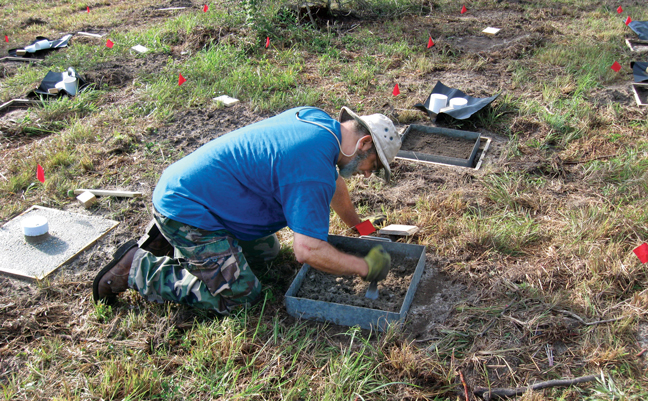
Dr. Shelton works on a groundboard installation. (PHOTO: CRAIG BELL (FPL-4723)/USFS)
Each year, the U.S. Department of Agriculture’s Forest Service (USFS) termiticide testing program provides updated data on standardized field studies performed with candidate termiticide products collected over the previous year. What follows is a formal summary of the data collected during the 2019 field season. In this report, the USFS publicly provides only data on those products that have obtained federal registration.
These studies date back to 1938, and were originally performed to supply the U.S. military with data on protecting wooden structures and crates. Today, these studies provide the U.S. Environmental Protection Agency (EPA) with the field data to support or refuse federal registration of candidate termiticide products.
Occasionally, a candidate termiticide manufacturer will decide to withdraw a product from testing. Our policy has been to not report on any products that do not obtain federal registration; due either to withdrawal or a product’s failure to meet the EPA’s performance standards. This prevents confusion and possible off-label use of agricultural products that contain the same active ingredient. While in the 2019 cycle, no new products were installed at the USFS termiticide testing sites. There continue to be two candidate termiticides being evaluated, and they are in the midst of their five-year efficacy data-collection period.
OVERALL METHODS
The USFS termiticide testing program works with cooperators from the chemical industry seeking efficacy data to satisfy federal registration requirements for potential new (or candidate) products. We offer installation and reading of plots using the groundboard, concrete slab and stake methods, as well as pesticide residual soil samples as an unbiased third party. These methods are the same as required by the EPA’s Office of Poisons, Pesticides and Toxic Substances (OPPTS) 810.3600 document. This document requires efficacy data for candidate termiticides for five years. Therefore, these studies from product installation to completion take six years to complete.
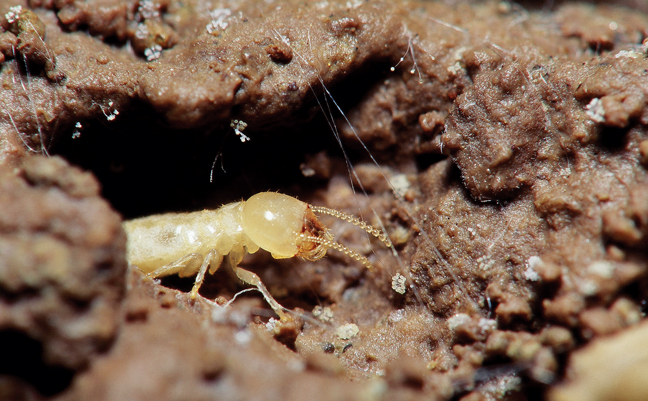
An Eastern subterreanan termite crawls on the soil it calls home. (PHOTO: COURTESY OF, AND COPYRIGHTED BY, GENE WHITE, PMIMAGES@EARTHLINK.NET)
We provide product manufacturers with annual updates on their products’ respective performances. Our final reports of the data to the manufacturers are included in their registration packages sent to the EPA. The EPA, as well as state regulatory agencies (once the product obtains federal registration), is free to contact the USFS regarding the data or methods used to obtain them.
In 1938, the USFS termite testing program used only the Harrison Experimental Forest (HEF) for these studies. Over the years, more sites were added and lost due to soil similarities to other sites, land swaps and administrative decisions. Currently, the following sites are in use:
- Chipola Experimental Forest in northwestern Florida.
- Harrison Experimental Forest in southern Mississippi.
- Calhoun Experimental Forest in western South Carolina.
Because only native subterranean termite species belonging to the genus Reticulitermes occur at these sites, our test data only applies to members of this genus.
TEST METHODS
The EPA’s Product Performance Test Guideline – OPPTS 810.3600 specifies two protocols for testing these products: the groundboard test and the modified groundboard (concrete slab) test. Ten replicates of each concentration, including water-only controls, are installed for each candidate termiticide in each of the three national field sites.
The methods are described in the annual termiticide report each year (Read more in PMP’s May 2017 issue and all earlier USFS annual termiticide reports). Because no procedural changes have been made, the language used to describe them remains relatively constant.
For the groundboard test, a 17×17-inch area is cleared of debris, roots and rocks and treated with the candidate termiticide. After drying, a 6×6-inch square pine sapwood board is centered on the exposed, termiticide-treated soil, and held in place with a brick.
The concrete slab test is similar. In this test, the treated plot area is also 17×17 inches and cleared as described above. After treatment, the soil is covered by a polyethylene vapor barrier, and a 21×21-inch concrete slab is poured around a 4-inch diameter polyvinyl chloride (PVC) pipe placed at the center.
Once the concrete has set, the vapor barrier is cut out and removed from the bottom interior of the pipe, and a 3.5×2.5×1.5-inch rectangular pine sapwood block is placed on the treated soil at the bottom of the pipe. To prevent weathering of the treated soil, a PVC cap is placed on the pipe. Completed plots form a grid in the forest.
For both methods, solutions of candidate termiticides are applied to the soil at the pre-construction rate of 1 gallon per 10 square feet in both test types. For each plot, the wood is evaluated for termite damage annually using a simple scale called the Gulfport scale, and the presence or absence of live termites infesting test blocks or boards is noted.
All currently registered soil-applied termiticide products have had their studies closed at the request of their respective manufacturers. No new products entered the market in 2019. Thus, there are no new products whose data can be revealed in this year’s report. The tables and data in this report are exactly the same as in the 2018 report (Read more in PMP’s June 2019 issue), as all of our recently collected data are for as-yet-unregistered products.
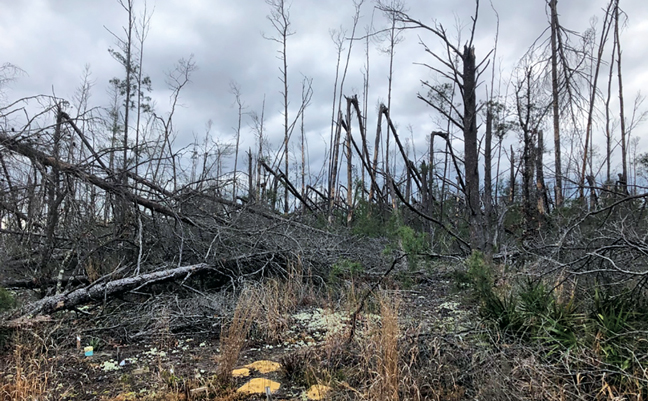
Chipola Experimental Forest plots (bottom left) and remnants of the tree canopy in February 2020. (PHOTO: DR. THOMAS SHELTON/USFS)
SOIL SAMPLING
Since 1998, the testing program has included extra groundboard and concrete slab plots for pesticide residue analysis at each concentration level of a newly installed product. Soil sample cores are 1 inch in diameter and 4 inches in length, collected both after installation and on each subsequent year of the study. The soil samples are then given to the product manufacturer for residue analysis of its product. These results can provide a timeline of product longevity and soil penetration depth at each time period for the product manufacturers. Note that the EPA guidelines do not require the soil sample data, and the methods for analysis are likely proprietary for each manufacturer. For these reasons, it would be impossible for the USFS to analyze the soil ourselves.
HURRICANE MICHAEL’S IMPACT
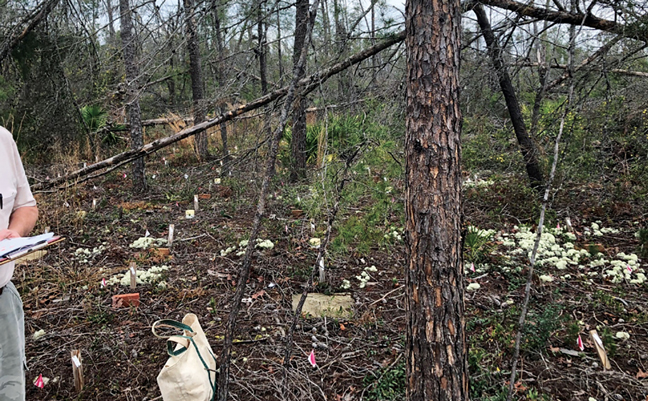
Recording data from plots at the Chipola Experimental Forest in February 2020. PHOTO: DR. THOMAS SHELTON/USFS
As mentioned in the 2018 USFS report (See “Hurricane Michael ravages Florida test site,” in PMP’s June 2019 issue), Hurricane Michael had damaged the Chipola Experimental Forest (CEF), where we maintain the Florida testing program plots. Our most recent visit to the CEF was in late February 2020. The photos above, right and below, were taken while reading plots on the CEF.
One of the most surprising observations was the underbrush in the forest. Last year, in discussing our expectations for this forest based on what we had seen following Hurricane Katrina on the HEF, we expected undergrowth to be out of control. However, as can be seen in the photos, even with the near 100 percent loss of canopy in the area, the undergrowth has not been excessive. This might be due in part to the amount of downed timber on the ground. Loss of canopy does allow more light to reach the lower areas of the forest, but undergrowth might still be blocked by the downed trees. Also, this was still early: Hurricane Michael occurred on Oct. 10, 2018, and February 2020 was only 16 months later.
Additionally, looking at the control plots from the largest study we read in both 2018 and 2020 shows some interesting results. What happens when all of the trees surrounding a study are felled by a hurricane? One might guess that termites would continue to follow their previously made tunnels and continue to feed at previously known feeding locations before and after such an event.
Anecdotally, we took the CEF reading data for 2018 and 2020 for an individual study with over seven concentrations. From those data, we counted the number of possible control plots for each year (to make sure none had been destroyed), and counted how many of those plots showed termite feeding each year. We did not include 2019, as that reading was six months after the hurricane and the fallen trees would not have been down long enough for heavy infestation.
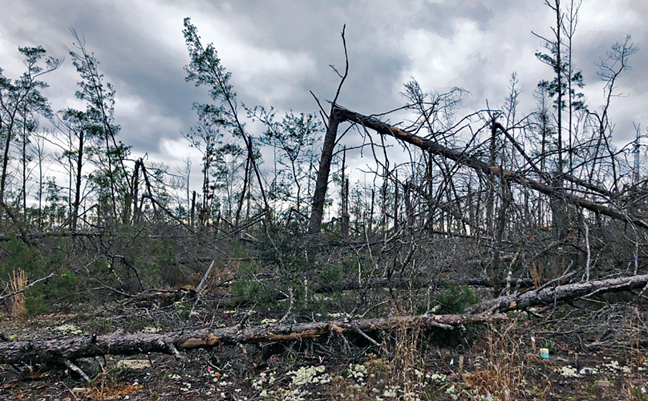
Many thin-diameter trees were able to survive Hurricane Michael, whereas thicker trees snapped. PHOTO: DR. THOMAS SHELTON/USFS
For 2018, the percentage of fed-upon controls was 91.25 percent. For 2020, this number was 57.5 percent.
It is possible that loss of shade cover could have reduced the number of termites foraging in the plot, or it may be that the downed trees make a difference in food choice (shown previously by Lenz et al., Proceedings of the IRG-WP, 2001). The sheer abundance of new food resources may be reducing the amount of termite feeding found on the control wood in the test plots. In either case, percentages of fed upon controls may be reduced in future readings at CEF.
Unfortunately, the timber salvage sale of the CEF was not successful. As a result, the remaining 900-plus acres of this site will need management by the local national forest and the Southern Research Station (SRS). The SRS oversees all three of the experimental forests where the termiticide testing program has plots.
Currently, the SRS is using the results of this hurricane to run experiments on the disturbance of forests, and lack of canopy effects on forest restoration. While some burning will likely take place, at press time, our unit has requested a burning restriction in our test plots and its surrounding border.
DATA INFORM DECISIONS
The USFS termiticide testing program has provided unbiased candidate termiticide efficacy data for the military and state and federal regulators for more than 80 years. The testing program has provided termiticide performance data for all products currently registered at the federal level. While the regulatory system and the chemical manufacturers ensure that the data are available to state and federal regulators, the USFS annual termiticide report provides the data annually to the pest management industry and the American consumer.
It is hoped that this information enables people to make informed decisions concerning the protection of the wood framing in their homes and other structures from termite damage. For the foreseeable future, the USFS termiticide testing program will continue to provide information about these products.
DR. SHELTON is a supervisory research entomologist; FYE is a biologist; DR. TANG is a research forest products technologist; and DR. MANKOWSKI is a research entomologist. All are with the USFS Forest Products Laboratory, Durability and Wood Protection Research unit, Starkville, Miss. Contact them at pmpeditor@northcoastmedia.net.
Leave A Comment